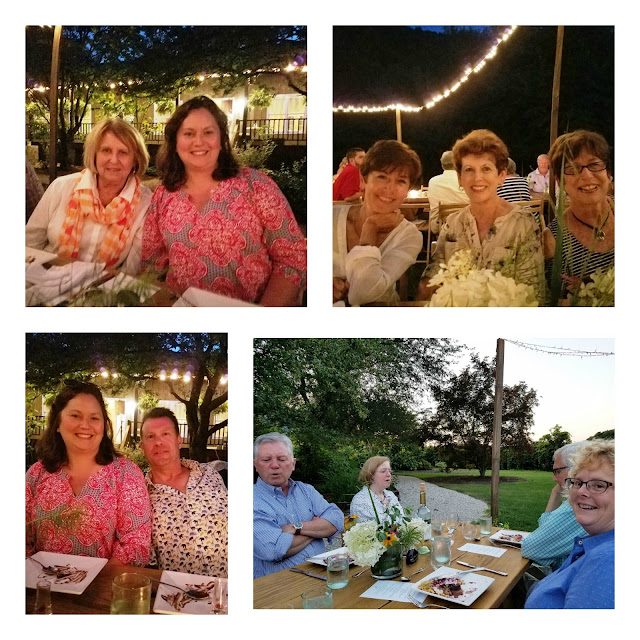I mentioned in a previous post my Panoply sisters and I were getting together the last weekend of July with fun things planned. One of those was attending a farm-to-table dining experience at a 200 year old, revived salt farm in West Virginia. The farm and business is named
J. Q. Dickinson Salt-Works. I have no affiliation with their company or products, but simply must share their unique success story and my experience at their farm-to-table event!
 |
| Farm-to-table at J. Q Dickinson Salt-Works |
When we arrived at the sold out event, imagine my surprise when I realized the revived salt farm's most recent former life was as a garden landscape center I visited in 2003, while planning our landscape renovation. Much of the garden center's original design remains.
 |
| Garden hardscape at J. Q. Dickinson Salt-Works |
Gravel pathways led us from the parking to the lawn setting for the meal event. A succulent planting at the entrance was gorgeously displayed in an urn at least two feet wide. A water fountain was running between a beverage table setup and a row of newly planted limelight hydrangea bushes on the perimeter of the lawn. The lawn itself was set with two rows of connecting farm tables, with a total of sixty or so chairs.
 |
| Weeping cedar Atlas at J.Q. Dickinson Salt-Works |
Across from the beverage table was this glorious weeping cedar Atlas.
This. This is the plant that mesmerized me 14 years ago to want one in my own landscape as a
specimen plant.
 |
| Main building at J. Q. Dickinson Salt-Works |
The main building, situated right behind the hydrangea plantings, serves as the kitchen, restroom facilities, offices, and retail shop for J. Q. Dickinson Salt-Works.
 |
| Neighbors and Panoply sisters |
As if the surprise of the location's former business as a gardening center wasn't enough, my sisters and I ran into some of my neighbors who had also come to the event. We all joined together, found our seats, got a drink, and assembled for a quick tour of the present-day working salt farm.
 |
| Nancy Bruns providing tour of Salt-Works processing |
Nancy Bruns, trained as a chef, is the creative brain responsible for and representing the 7th generation descendants of the J. Q. Dickinson Salt-Works. Armed with the family's original well logs and maps, Nancy and her attorney brother, Lewis, teamed up and enlisted professionals to attempt tapping the salt river beneath the farm land, two hundred years after their ancestors originally tapped it. The salt beds from which the brine is extracted are the result of the Iapetus Ocean, the body of water predating the Atlantic Ocean (400-600 million years ago)! These salt beds and salt river lie beneath the Appalachian mountains.
 |
| Inside the J. Q. Dickinson Salt-Works Evaporation House |
This tour was full of fascinating facts! As a result of the continental plate shifts, the Iapetus Ocean disappeared, but the brine kept bubbling up. By 1815, the Dickinson family had several salt wells established on their farm, and the surrounding river valley became a hotbed, leading the salt industry, long before the coal and natural gas industries of West Virginia were born. At the time, salt was necessary to cure meats, as there was no refrigeration. Competition was only as near as Syracuse, New York, so the Kanawha Salt - named for the river valley from which it was extracted - became the epicenter of the country's salt production.
 |
| J. Q. Dickinson Salt-Works Processing and Packaging facility, product package |
By the mid-1800's the Kanawha Salts were enjoying its heyday, even winning an award as the world's best at the London World's Fair in 1851! However, with railroad connectivity, competition increased, and the Kanawha Salts waned by the 1950's. After being mothballed over 60 years, the brother-sister team took the risk to revive the salt production. With the aid of the family records, brine was successfully found nearly 350 feet below the farmland's surface.
The original Dickinson salt works would have used coal-fired furnaces to boil the brine. Although the original family barn and remnants of the old wells still stand on the farm, J. Q. Dickinson's salt today is processed differently than their previous generations' salt. Theirs is an artisanal operation, pumping the brine from the ground and processing the it in a nature-friendly operation. They are utilizing evaporation rooms, basically resembling large
hoop houses, with the natural rays of the sun and mountain air transforming the brine into salt crystals. Inside the hoop houses can get up to 150° degrees on 90° degree days, and high humidity slows the process. The salt is scraped from the beds and further dried in cotton wraps.
 |
| J. Q. Dickinson salt crystals |
The J. Q. Dickinson Salt Works is enjoying success, and is utilizing/marketing as much of its by-products as possible. Nigari, used to make tofu, is one of the salt process by-products, as is iron, which is being converted to nautral dye. J. Q. Dickinson enjoys a niche market, selling primarily to gourmet shops and restaurants. It is the only sea salt of its kind, without heavy metals. It is "94.5% sodium chloride, 3% calcium and 1.5% trace minerals, including potassium", as stated on their website. The link to their website is provided in my leading paragraph (and again at the end of this post). I invite and encourage you to explore this fascinating small business.
 |
| J. Q. Dickinson Salt-Works Appalachian Salt Sampler: Ramp, Heirloom, and Smoked |
As part of celebrating the business success and further market their salt, J. Q. Dickinson began a series of farm-to-table dining events on location in 2015. Different chefs from surrounding WV locales have been host to the meals, and our dinner was prepared by West Virginia chef Anne Hart of Bridgeport, WV. You can see our menu in the photo below, along with photos of the second, third and fourth courses.
The salted chocolate creme dessert was so delicious, it was gone before I could think to snap a photo. The blueberry shrub was notably an aperitif attributable to Thomas Jefferson, as per Chef Hart. It was intended to soothe the stomach after partaking of rich foods. It was a vinegar-based shot with a blueberry infusion.
 |
| The Provence Market menu and three courses |
In its inaugural year, the drinking policy was BYOB for the farm-to-table events. This year, wines were paired for the series of meals and made available for purchase. We selected the Barboursville Pinot Grigio.
 |
| Wine pairings for the Provence Market event |
The weather was absolutely perfect for our evening, with low humidity and low 80's for temperature.
 |
| Dinner guests at the J. Q. Dickinson Salt-Works Provence Market event |
The moon was just a sliver that evening.
The company was most enjoyable. We laughed and talked all evening long, commenting on the various courses, each of us having varied opinions and degrees of hesitancy with what we ate. :)
The evening lasted from 6:30 pm to around 9 pm, and my sisters and I left with a strong desire to return again, and bring our husbands.
 |
| The evening ending |
My sisters and I each purchased a variety of items, though not at the event. We went to our
Capitol Market the next day. Situated in a revitalized railroad freight station, our market houses vendors both indoors and outside, and is home to the Charleston Visitors' Center (exit 100, I-64/77E). Inside is the West Virginia Marketplace, a smorgasboard of locally made products, including J. Q. Dickinson Salt-Works,
Brookstone Soaps, and
Allegheny Treenware (wood utensils).
 |
| Capitol Market, Charleston,, WV |
I bought the items you see pictured below: the Appalachian Salt Sampler, a small, carved wooden salt spoon made by Allegheny Treenware, a bar of soap, and a jar of burnt caramel sauce.
 |
| J. Q. Dickinson Salt-Works purchases |
The day after the event, I made myself a treat using one of locally grown white peaches I had also purchased at the market. I used French vanilla ice cream, peaches, and J. Q. Dickinson burnt caramel sauce, with a pinch of heirloom salt for good measure. Needless to say, it was the perfect summer dessert, and has me dreaming of ways to use the caramel this fall.
 |
| Dessert! |
Without a doubt, this event was a highlight for me this summer. I knew when the schedule was announced back in March that I would be going to one of these events, and my choice for this one was remarkable. Other farm-to-table events are popping up around the state, including a series at the Capitol Market, but the J. Q. Dickinson event was first class!
I've been purchasing JQD's salt grinders and various other small items as hostess gifts for a couple years now, and the website offers many more now. The tomato jam is calling my name! Again, here's the website if you'd like to learn more about this great little success story:
J. Q. Dickinson Salt-Works. There's a tab to shop online, too.
Thank you for coming along on this adventure with me. Your readership is appreciated. Feel free to leave your comments or questions!
Rita C. at Panoply
Sharing: Amaze Me, DIDI, BNOTP, Gardens Galore, Show & Share, Inspire Me, Make it Pretty, The Scoop, Celebrate Your Story, SYS, SYC, Delightsome Life H&G, Reader Tip Tuesday, Grace at Home, Foodie Friday & Everything Else




















No comments:
Post a Comment